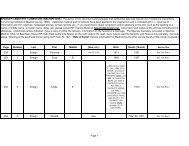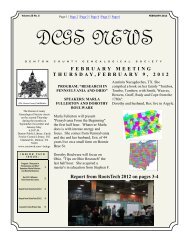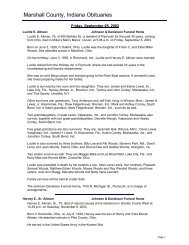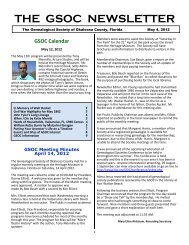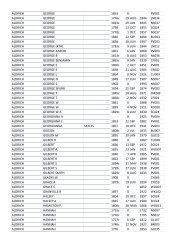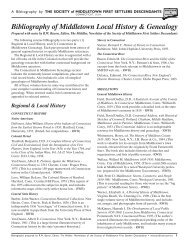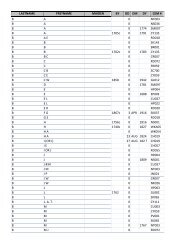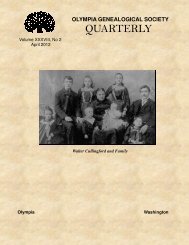Getting to the Roots of Your Family - RootsWeb - Ancestry.com
Getting to the Roots of Your Family - RootsWeb - Ancestry.com
Getting to the Roots of Your Family - RootsWeb - Ancestry.com
You also want an ePaper? Increase the reach of your titles
YUMPU automatically turns print PDFs into web optimized ePapers that Google loves.
• http://www.genealogienetz.de/reg/ESE/slovak.html - general information, links <strong>to</strong> maps,<br />
societies, lists <strong>of</strong> genealogical resources.<br />
Galicia<br />
The lands acquired by <strong>the</strong> Austro-Hungarian Empire as a result <strong>of</strong> <strong>the</strong> partitions <strong>of</strong> <strong>the</strong> Kingdom <strong>of</strong><br />
Poland in 1772, 1815, and 1846 became <strong>the</strong> crown land <strong>of</strong> Galicia. It reached from Krakow in <strong>the</strong> West<br />
<strong>to</strong> L’viv in <strong>the</strong> East. Today, <strong>the</strong> Western half belongs <strong>to</strong> Poland, and <strong>the</strong> Eastern half <strong>to</strong> <strong>the</strong> Ukraine.<br />
The population was mostly Polish and Ru<strong>the</strong>nian, with a small German minority. Most <strong>of</strong> <strong>the</strong> Germans<br />
came from <strong>the</strong> South German areas and Austria, as well as <strong>the</strong> Sudetenland and o<strong>the</strong>r Germanspeaking<br />
areas. Helpful Web sites for locating German villages:<br />
• http://www.semanchuk.<strong>com</strong>/gen/maps/unterschutz.html - a good map showing <strong>the</strong> German<br />
villages in Galicia<br />
• http://www.semanchuk.<strong>com</strong>/gen/maps/UnterschutzIndex.html. - An index <strong>to</strong> <strong>the</strong> above map<br />
The German villages were generally ei<strong>the</strong>r Catholic or Lu<strong>the</strong>ran; very few were mixed. Catholic settlers<br />
tended <strong>to</strong> intermarry with <strong>the</strong> Polish majority. Lu<strong>the</strong>rans did not assimilate as easily and thus<br />
maintained <strong>the</strong>ir German language and culture intro <strong>the</strong> 1900’s. Lists <strong>of</strong> original German settlers in<br />
Galicia are found in Das Kolonisationswerk Josefs II in Galizien by Ludwig Schneider [FHL INTL Q<br />
943.86 W2sL, FHL INTL Film<br />
1256477 Item 1]<br />
Helpful Web sites:<br />
• The Galizien German Descendants Society website http://www.galiziengermandescendants.org/<br />
includes instructions for family his<strong>to</strong>ry research, maps, village his<strong>to</strong>ries, pictures, and o<strong>the</strong>r<br />
helpful material.<br />
Very reasonably priced <strong>to</strong>wn genealogy books have been published on CD-Rom for many<br />
German villages in Galicia. Purchase information is found here.<br />
• www.galizien.org – includes extracted church records from German parishes in Western and<br />
Eastern Galicia. Click on “Datenbanken”.<br />
• http://www.genealogienetz.de/reg/ESE/galicia.html - Includes addresses <strong>of</strong> archives that hold<br />
church records for <strong>the</strong> various regions.<br />
• http://www.eegsociety.org/Home.aspx -East European Genealogical Society<br />
• http://www.halgal.<strong>com</strong>/index.htm - includes sections on locating <strong>the</strong> ancestral <strong>to</strong>wn in Galicia,<br />
using gazetteers, finding records, and o<strong>the</strong>rs - very informative.<br />
• http://www.lvov.us/galician-genealogy/ - Galician genealogy resources<br />
Bukovina<br />
Organized migration <strong>of</strong> Germans in<strong>to</strong> <strong>the</strong> Bukovina began around 1775. In 1910, <strong>the</strong> Germans were <strong>the</strong><br />
third largest ethnic group in Bukovina, with over 20 % <strong>of</strong> <strong>the</strong> population. German colonists came from<br />
three distinct areas: southwest Germany; <strong>the</strong> Böhmerwald area in <strong>the</strong> Czech Republic; and <strong>the</strong> Zips<br />
mountains, now Spis county, Slovakia. German emigration from Bukovina <strong>to</strong> <strong>the</strong> United States,



